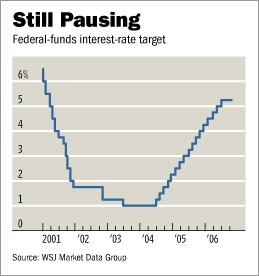Bottom Line - Inflation is up but not up enough for a Fed Rates hike. Also, an interesting statement by Rajeev Dhawan, director of the Economic Forecasting Center at Georgia State University. He predicts the Fed will cut rates by January. "With long-term rates well below short-term rates -- a relationship that in the past has foreshadowed recession -- 'the risk factors are too high,' he said."
Fed Again Leaves Rates Unchanged
The Wall Street Journal
Central Bank Remains
Worried About Inflation
But Sees Pressures Easing
By GREG IP
WASHINGTON -- The Federal Reserve held short-term interest rates steady for its third consecutive meeting as it continued to bet on a moderation of both inflation and economic growth.
Even as it left rates at 5.25% yesterday, the Fed again warned that it is worried about inflation.
Since Ben Bernanke became Fed chairman in February, he has faced, first, the threat of rising inflation and then a housing-led economic slowdown. The latest data, and the statement released by the Fed after its meeting yesterday, suggest that the central bank sees the risks on both sides diminishing. That makes it less likely that rates will change in either direction in coming months.
Both the rate action and statement were largely expected. Bond prices rallied and bond yields, which move in the opposite direction to prices, fell, apparently because investors had expected more hints of a possible rate increase.
Futures markets' expectations of Fed actions have swung sharply in the past month, from betting on several rate cuts starting as soon as December to seeing a small probability that the Fed might raise rates.
In its statement, the Fed said growth has slowed in part because of a "cooling" housing market. "Going forward, the economy seems likely to expand at a moderate pace," it said, a notable addition to its statement released after last month's meeting.
Core inflation, which excludes food and energy, remains "elevated" but inflation pressures are likely to moderate thanks to lower energy prices, "contained" inflation expectations, and the impact of previous rate increases, the Fed said.
"Some inflation risks remain," the Fed said, but whether rates would rise again depends on the outlook and "incoming information."
For the third straight meeting, Federal Reserve Bank of Richmond President Jeffrey Lacker cast the lone dissent among the 11 voting members of the Federal Open Market Committee. He argued in favor of a quarter-percentage point rate increase in the target federal-funds rate, charged on overnight loans between banks. (One voting seat is empty and seven other members don't vote.)
Mr. Bernanke has faced shifting challenges since taking office. Core inflation has risen to 2.9% from 2.1%, the highest level in a decade. Although inflation by the Fed's preferred price index is lower, it, too, is above the 2% level many Fed officials have said they are comfortable with. That led the Fed to raise rates at its first three meetings under Mr. Bernanke.
Then later economic growth, under the weight of falling home and automobile sales, began to slow, to an estimated annual rate of about 2% in the third quarter. That would be the second-lowest level since 2003. The official growth figure will be reported tomorrow.
In recent weeks, though, both inflation and growth worries have eased. Energy prices have plunged, and the Fed expects the indirect impact of that drop to pull down core inflation in the coming year or so. Yesterday's Fed statement dropped a reference from the previous month to energy and commodity prices as a source of inflation pressure.
There is little sign the economy outside housing and cars has slowed much. Some economists said the housing market has shown tentative signs of hitting bottom.
Yesterday, the National Association of Realtors said existing-home sales fell 2% in September to an annual rate of 6.18 million, from August. The inventory of existing homes remained at about 7.3 months of sales for the third consecutive month.
"We might be having what some colleagues have described as a false landing rather than soft landing," said Carl Tannenbaum, chief economist at LaSalle Bank. He said growth could rebound to 3% in the current quarter as the housing correction ends and consumers benefit from a 25% to 40% drop in gasoline prices.
"The Fed must ask itself: Did things slow down long enough and far enough to reduce pressure on capacity? I think the next move [on rates] is probably up."
Rajeev Dhawan, director of the Economic Forecasting Center at Georgia State University, predicted the Fed would cut rates by January. With long-term rates well below short-term rates -- a relationship that in the past has foreshadowed recession -- "the risk factors are too high," he said.
The shifting momentum of growth from strong to weak and back to moderate reflects the remarkable stability the U.S. economy now enjoys, said John Makin, a scholar at the American Enterprise Institute. "As has often been the case over the past five years, the slowdown itself has set into motion market adjustments that may mitigate or even reverse it," he wrote in a report.
For example, the Fed's decision to pause as the housing market weakened led investors to drive down long-term rates on bonds and mortgages. That, with a lag, has helped put a floor under housing.
Online lender Quicken Loans Inc.'s pipeline of mortgage applications has grown 20% to 25% since rates began to ease in late June, said the company's chief economist, Bob Walters. The increase has been driven mostly by refinancing applications, while the number of applications for new-home purchases remains steady. "Whether we've seen the bottom or not, remains to be seen," he said.
Write to Greg Ip at greg.ip@wsj.com
Sunday, October 29, 2006
Fed Again Leaves Rates Unchanged
Posted by Brian Borden at 1:52 PM
Subscribe to:
Post Comments (Atom)





0 comments:
Post a Comment